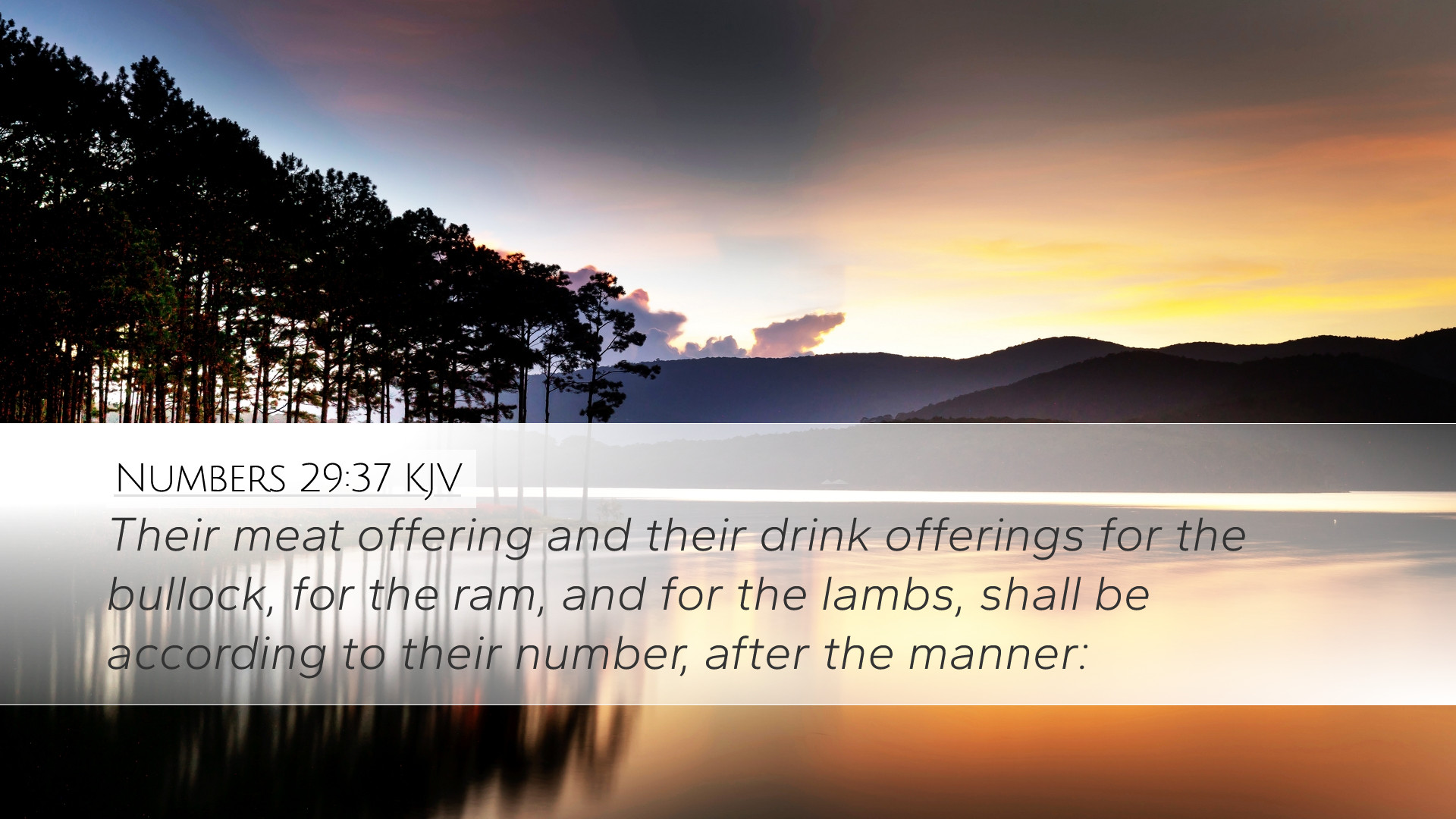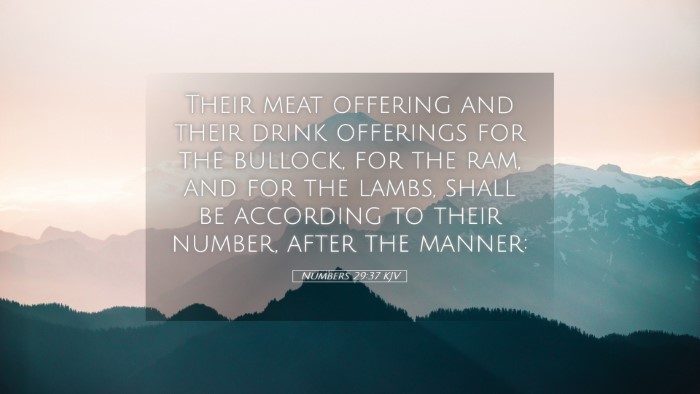Commentary on Numbers 29:37
Numbers 29:37 reads, “And one kid of the goats for a sin offering, besides the sin offering of atonement, and the continual burnt offering, and the meat offering of it, and their drink offerings, according to their manner, for a sweet savour unto the LORD.” This verse appears in the context of the offerings made during the Feast of Tabernacles, where the Israelites were instructed to present various offerings as a way of worship and atonement.
Contextual Background
Understanding this verse requires a grasp of the sacrificial system in ancient Israel, which served not only as a means of atonement but also as expressions of worship and community thanksgiving. The offerings specified highlight the intricate relationship between God and His people, emphasizing themes of atonement, gratitude, and holiness.
Insights from Matthew Henry
Matthew Henry, in his exposition, notes that all offerings should be made with the right intentions. He emphasizes that the mention of “one kid of the goats for a sin offering” symbolizes the necessity of atonement. Although there were many offerings during the Feast, this sin offering emphasizes the importance of recognizing sin and the need for reconciliation with God.
-
Acknowledgment of Sin: Henry’s commentary stresses that every worshipper must acknowledge their personal sins before approaching God. The inclusion of a sin offering in the festival signifies a continual need for purification.
-
The Unity of Offerings: He also points out the interconnectedness of the offerings. The sin offering cannot be separated from the continual burnt offerings and the grain offerings. Each has its place in the act of worship and signifies ongoing devotion and humility before the Lord.
Insights from Albert Barnes
Albert Barnes adds depth by explaining the symbolism of the offerings. He highlights that the goat’s kid represents Christ, the ultimate sacrifice for sin. In his view, the repetition of these sacrifices indicates a foreshadowing of the need for Christ’s atonement.
-
The Role of the Offerings: Barnes identifies that each type of offering serves a unique purpose within the worship framework. The sin offering addresses transgressions, while the burnt offering represents total dedication to God, and meal and drink offerings signify thankfulness.
-
Sweet Savour unto the LORD: The phrase “for a sweet savour unto the LORD” reinforces the idea of pleasing God. Barnes interprets this as an assurance that God finds joy in the sincere acts of worship and the offerings that represent the hearts of the worshippers.
Insights from Adam Clarke
Adam Clarke emphasizes the meticulous nature of the offerings and the importance of following God's instructions precisely. He views the detailed protocols of worship as essential for maintaining a relationship with God. Clarke specifically remarks on the necessity of a sin offering as a means of acknowledging human frailty and need for divine mercy.
-
Divine Ordinance: Clarke explains that God’s directives regarding offerings must be obeyed to maintain holiness and righteousness within the community of Israel. The prescribed rituals act as a constant reminder of God’s holiness and the people’s dependence on His mercy.
-
Spiritual Implications: He argues that these offerings go beyond mere ritual; they symbolize deep spiritual truths about humanity's need for redemption. This understanding connects the Old Testament practices with New Testament teachings about Christ's atoning work.
Theological Reflections
The offerings detailed in Numbers 29:37 invite profound theological reflections on atonement, sacrifice, and worship. The integration of various offerings signifies the multifaceted relationship between the divine and human realms.
-
Atonement and Grace: The necessity of a sin offering underscores the theological principle that all have sinned and fall short of the glory of God (Romans 3:23). The sacrifice prepares the heart for a renewed relationship with God, illustrating His grace towards flawed humanity.
-
Worship as Holistic: The various offerings signify that worship encompasses more than just acknowledgment of sin; it also includes gratitude and a commitment to godly living. This holistic approach to worship is essential for spiritual health.
-
Christ as the Fulfillment: The early offerings foreshadow Christ, who became the ultimate sacrifice (Hebrews 10:1-10). Understanding the Old Testament sacrificial system frames the significance of Christ’s sacrifice, encouraging believers to appreciate the continuity within Scripture.
Conclusion
In summary, Numbers 29:37 serves as a vital reminder of the importance of sin offerings and how they relate not only to ancient Israel’s worship practice but also to contemporary understanding of grace and salvation through Christ. The insights offered by Matthew Henry, Albert Barnes, and Adam Clarke provide a rich tapestry of interpretation for pastors, students, theologians, and scholars. Their perspectives urge a deeper examination of one’s spiritual life and invite believers to engage genuinely in worship, seeking a deeper relationship with God through sincere acknowledgment of their need for Him.


